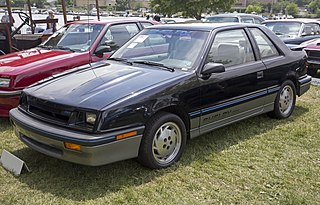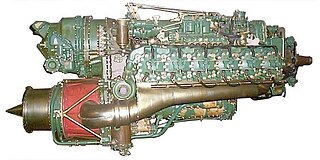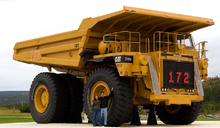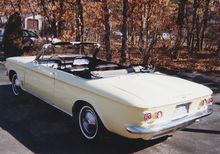
In an internal combustion engine, a turbocharger is a forced induction device that is powered by the flow of exhaust gases. It uses this energy to compress the intake air, forcing more air into the engine in order to produce more power for a given displacement.

The Fiat Croma name was used for two distinct large family cars by Fiat, one a five door liftback manufactured and marketed from 1985 to 1996, and after a nine-year hiatus, a crossover station wagon manufactured and marketed from 2005 to 2010.

The 2.2 and 2.5 are a family of inline-4 engines developed by Chrysler Corporation originally for the Chrysler K- and L-platforms cars and subsequently used in many other Chrysler vehicles. After its launch in 1981, it became the basis for all Chrysler-developed 4-cylinder engines until the Chrysler 1.8, 2.0 & 2.4 engine family was released in 1994. It was the first Chrysler engineered four cylinder engine since the Chrysler flathead four cylinder was discontinued in 1933.

Power Stroke, also known as Powerstroke or PowerStroke, is the name used by a family of diesel engines for trucks produced by Ford Motor Company and Navistar International for Ford products since 1994. Along with its use in the Ford F-Series, applications include the Ford E-Series, Ford Excursion, and Ford LCF commercial truck. The name was also used for a diesel engine used in South American production of the Ford Ranger.

The Shelby CSX was a limited-production high performance automobile based on the turbocharged intercooled Dodge Shadow and Plymouth Sundance. These cars were offered by Shelby Automobiles Inc. from 1987 through 1989. The CSX serial number was established by AC Cars, in Surrey, England. The purpose of that serial number was to identify which chassis were to be exported to Shelby in the U.S. CSX stood for "Carroll Shelby Export".

The Saab B engine is an inline four-cylinder car petrol engine developed by Saab Automobile. A redesign of the Triumph slant-four engine, the B engine displaced 2.0 L and first appeared in 1972. The B engine was used in the Saab 99 and 900 models. Saab began to phase the engine out in 1981.
A wastegate is a valve that controls the flow of exhaust gases to the turbine wheel in a turbocharged engine system.

Variable-geometry turbochargers (VGTs), occasionally known as variable-nozzle turbochargers (VNTs), are a type of turbochargers, usually designed to allow the effective aspect ratio of the turbocharger to be altered as conditions change. This is done with the use of adjustable vanes located inside the turbine housing between the inlet and turbine, these vanes affect flow of gases towards the turbine. The benefit of the VGT is that the optimum aspect ratio at low engine speeds is very different from that at high engine speeds.
In an internal combustion engine, twin-turbo is a layout in which two turbochargers work in tandem to compress the intake fuel/air mixture. The most common layout features two identical or mirrored turbochargers in parallel, each processing half of a V engine's produced exhaust through independent piping. The two turbochargers can either be matching or different sizes.

The term turbo-diesel, also written as turbodiesel and turbo diesel, refers to any diesel engine equipped with a turbocharger. As with other engine types, turbocharging a diesel engine can significantly increase its efficiency and power output, especially when used in combination with an intercooler.
The N series is Honda's first automotive diesel engine, an inline-four for medium-sized vehicles. It uses common rail direct injection, which Honda brands as i-CTDi. The most notable feature is the aluminium block, which uses proprietary technology in the manufacturing process to provide light weight and high rigidity. Roller chains drive two overhead camshafts. A variable-geometry turbocharger and intercooler are used.

A turbo-compound engine is a reciprocating engine that employs a turbine to recover energy from the exhaust gases. Instead of using that energy to drive a turbocharger as found in many high-power aircraft engines, the energy is instead sent to the output shaft to increase the total power delivered by the engine. The turbine is usually mechanically connected to the crankshaft, as on the Wright R-3350 Duplex-Cyclone, but electric and hydraulic power recovery systems have been investigated as well.

The YD engine is a 2.2 and 2.5 L inline-four diesel engine from Nissan. It has a cast-iron block and aluminium head with chain driven twin overhead camshafts. The engine shares much of its architecture with the QR petrol engine.

Garrett AiResearch was a manufacturer of turboprop engines and turbochargers, and a pioneer in numerous aerospace technologies. It was previously known as Aircraft Tool and Supply Company, Garrett Supply Company, AiResearch Manufacturing Company, or simply AiResearch. In 1964, Garrett AiResearch merged with Signal Oil & Gas, to form a company renamed in 1968 to Signal Companies. In 1985, it merged with Allied Corporation, forming AlliedSignal. In 1999 AlliedSignal acquired Honeywell and adopted the Honeywell name.
Gale Banks is an American hot rodder, drag racer, engineer, and entrepreneur who grew up in Lynwood, California. His company, Gale Banks Engineering, sells performance parts for automotive and marine engines. It specializes in diesel engines, and high end cutting-edge equipment, performance parts, and auxiliaries. The company has approximately 100+ employees.

An electrically assisted turbocharger (EAT) is an arrangement where an electric motor assists the gas-driven turbocharger in providing forced induction, particular at times when exhaust gas flow is insufficient to produce the desired boost. Some systems integrate the motor inside a turbocharger, while others use a separate electric supercharger.
Gale Banks Engineering and its four divisions, Banks Power, Banks Technology, Banks Marine, and Banks Racing, are companies created by Southern California hot rodder and automobile engineer Gale Banks. These companies design, engineer, and build high performance parts for the automobile and marine aftermarket and military customers. Located in Azusa, California, the company develops technology and components for both gasoline and diesel-powered vehicles, but is best known for advancing development of the turbocharger and ultra high performance diesel engines for racing and street purposes.

TDI is Volkswagen Group's term for its current common rail direct injection turbodiesel engine range that have an intercooler in addition to the turbo compressor.
Turbochargers have been used on various petrol engines since 1962, in order to obtain greater power or torque output for a given engine displacement.

















